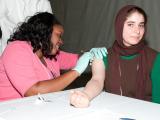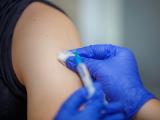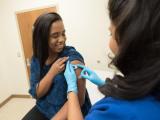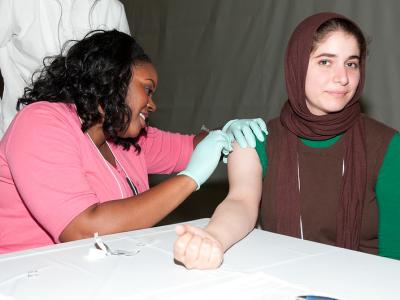Nov 17, 2010
NIAID experts expect major flu vaccine advances in next decade
In a review of new influenza vaccine technologies, two experts from the National Institute of Allergy and Infectious Diseases predict that the next decade will bring advances that "will substantially decrease vaccine production time, provide enhanced protection (especially in populations at greatest risk), and end mismatches between vaccine strains and circulating viruses." The article, by Linda C. Lambert, PhD, and NIAID Director Anthony S. Fauci, MD, was released online today by the New England Journal of Medicine (NEJM). The pair say moving from egg-based to cell-based production and adding adjuvants are "steps in the right direction," but the best hope for "revolutionizing" the field lies in new vaccine technologies. In a discussion of next-generation vaccines, they look at recombinant proteins, virus-like particles, viral vectors, DNA-based vaccines, and research on "universal" vaccines. A vaccine
that provides lifelong protection against flu may not be achievable, but the goal of a vaccine that would be given every few years instead of annually and would protect against genetically drifting strains and emerging pandemic strains is worth pursuing, the authors maintain.
Nov 17 NEJM article
NIH awards $10 million to develop skin-patch flu vaccine
The idea of using a skin patch studded with tiny, dissolving needles to deliver influenza vaccines has received a $10 million boost in the form of a National Institutes of Health grant to three institutions involved in developing the technology. The 5-year grant was awarded to the Georgia Institute of Technology, Emory University, and PATH, the Seattle-based nonprofit organization, according to a Georgia Tech news release. The funds will be used to address key technical issues and move the microneedle patch through a phase 1 clinical trial, according to the release. The grant also will be used to compare the effectiveness of the patch and that of traditional intramuscular flu vaccines. The microneedle patches, which contain hundreds of needles so small that they penetrate only the outer layers of skin, could be applied painlessly by patients, officials said. "We believe that this technology will increase the number of people
being vaccinated, especially among the most susceptible populations of children and the elderly," said Mark Prausnitz of Georgia Tech, the project's principal investigator.
Nov 16 Georgia Tech press release
Jul 19 CIDRAP News story on animal test of microneedle patch
CDC updates advice for antiviral treatment in flu patients
The US Centers for Disease Control and Prevention (CDC) has updated its recommendations on antiviral treatment for influenza for the 2010-11 season, keeping them generally in line with the 2009-10 recommendations. The agency recommends prompt antiviral treatment for patients with severe or progressive illness and those at higher risk for flu complications. The recommended medications are oseltamivir (Tamiflu) and zanamivir (Relenza), since recent data show that more than 99% of flu strains in circulation are sensitive to them. Although oseltamivir is not approved for use in infants less than 1 year old (and an emergency use authorization issued during the H1N1 pandemic has expired), the CDC recommends its use for treatment or prevention in this age-group when indicated, since infants face an increased risk of complications. The agency says that patients who have mild illness and are not at risk for flu complications are not
likely to benefit from antiviral treatment begun more than 48 hours after illness onset. Clinicians are advised to monitor national, state, and local antiviral recommendations during the flu season, since they may change, particularly depending on resistance profiles of circulating flu strains.
CDC antiviral recommendations for 2009-10 season
Pandemic H1N1 could become more virulent, reassort with seasonal flu
The pandemic strain of influenza H1N1 could evolve to become more virulent, say the authors of a study published yesterday in mBio, and its propensity to reassort with seasonal H1N1 strains could increase in the future. The researchers sought to fill several holes in current knowledge of the behavior of H1N1 strains, namely, the genomic-scale interaction between the pandemic and seasonal strains, the pattern of further adaptation of pandemic H1N1 to humans, and whether adaptation could mean higher virulence. They co-infected differentiated normal human bronchial epithelial cells with seasonal H1N1 and pandemic H1N1 viruses in three different ratios (10:90, 50:50, 90:10). When the pandemic strain was originally present in higher or equal proportion to the seasonal, only pandemic virus genotypes were found in the progeny viruses. The adapted viruses, however, contained mutations that caused a more virulent
phenotype than the parent viruses when tested in cell culture and in ferrets. When the seasonal strain was originally present in larger proportion, a reassortant containing the hemagglutinin gene from that strain and the remaining genes from the pandemic strain was found. With future reassortment would likely come a neuraminidase inhibitorresistant pandemic strain, given that such resistance has developed in seasonal strains recently, say the authors.
Nov 16 mBio article
Amount of egg in flu vaccine varies, according to study
Researchers found that influenza vaccines can contain varying amounts of allergenic components like egg or gelatin, according to a study presented at the American College of Allergy, Asthma and Immunology annual meeting that wrapped up yesterday. Allergists suggest that any patient who is allergic to eggs or gelatin or has had a severe reaction to a flu vaccine be tested to the specific vaccine lot number that he or she will be given before being immunized, according to a Medical News Today article. "It should never be assumed that tolerating one dose of influenza vaccine suggests future tolerance," the authors said. The CDC recommends that those who have a severe egg allergy not receive the influenza vaccine, but the American Academy of Allergy, Asthma and Immunology (AAAAI, a different organization, which did not sponsor the meeting) said last month that, given proper precautions, most egg-allergic people do not need a
skin test before receiving a flu vaccine.
Nov 16 Medical News Today article
CDC guidance on vaccine safety
Oct 15 CIDRAP News story on the AAAAI recommendations
















